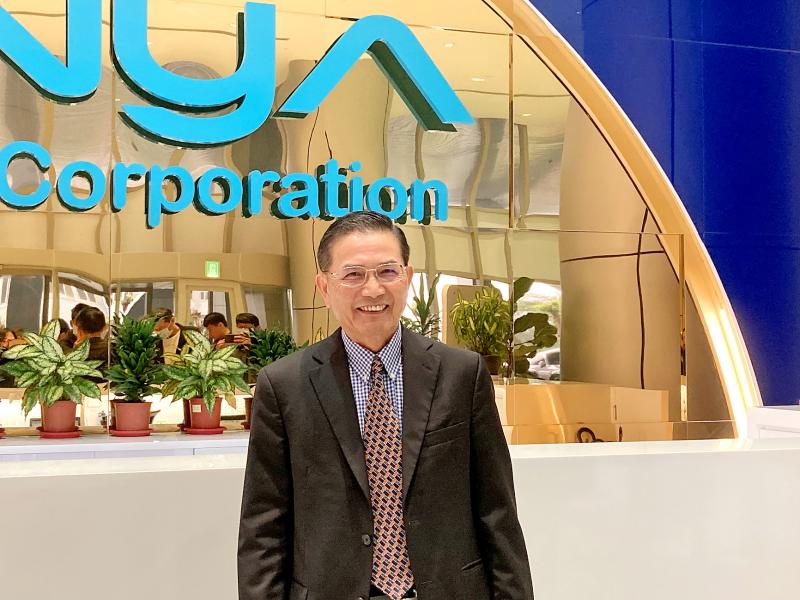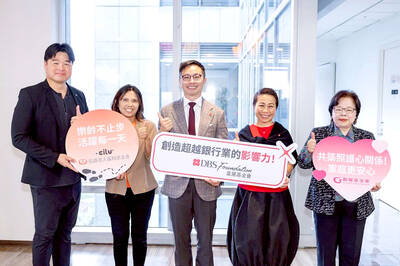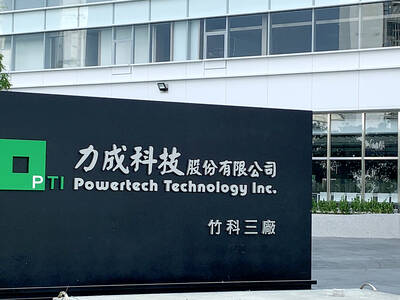Nanya Technology Corp (南亞科技) yesterday said net profit last quarter declined 14.3 percent from the previous quarter, but added that it has seen positive signs that the industry could rebound next quarter.
The nation’s biggest DRAM chipmaker had previously said that the most recent correction in the industry would last for about two quarters, and would be much shorter and milder than the previous downcycles, as the number of suppliers had fallen substantially.
“We are seeing an uptrend in the spot prices [for standard DRAM] in the first quarter. The price declines in contract-based prices are slowing down significantly from the fourth quarter,” Nanya Technology president Lee Pei-ing (李培瑛) told an online media briefing.

Photo: Lisa Wang, Taipei Times
The company expects average selling prices for DRAM chips to decline by a low-single-digit percentage this quarter from last quarter, and said they might rise again next quarter.
Overall, the company is optimistic about market demand this year, Lee said.
Demand for cloud-based servers is the strongest, while demand for smartphones, PCs and consumer electronics remain healthy this year, he said.
Component shortages, which restrain electronics shipments, would alleviate in the second half of this year, Lee said.
However, the company is wary of inflationary pressures and geopolitical tensions, which could dampen demand growth.
To speed up migration to next-generation technologies, Nanya Technology plans to boost its capital spending this year to NT$28 billion (US$1 billion) mostly to develop a new generation of “10-nanometer-class” memory chips, compared with NT$11.3 billion spent last year.
The 10-nanometer class indicates chips are made using process technologies of between 10 nanometers and 20 nanometers.
The company plans to ramp up production of its first-generation “10-nanometer-class” chips this year and the second generation probably next year, Lee said.
The company’s output is expected to change little this year, lagging behind the memory industry’s demand growth of 15 to 20 percent.
“That is a challenge for us. We have to quicken our pace in developing our own research and development capabilities to support growth,” Lee said.
Nanya Technology plans to start building a new 12-inch fab in the first half of this year, two quarters behind schedule, due to the bureaucratic hurdles.
The company reported that net profit last quarter fell to NT$6.45 billion, from NT$7.53 billion in the previous quarter, with earnings per share (EPS) of NT$2.08, down from NT$2.44 a quarter earlier.
A year earlier, it posted net profit of NT$924 million, or EPS of NT$0.3.
For the whole of last year, net profit soared to NT$22.85 billion, from NT$7.69 billion in 2020, while EPS jumped to NT$7.4 from NT$2.51.
Separately, Macronix International Co (旺宏電子), the world’s biggest NOR flash supplier, on Tuesday said net profit last quarter grew 219 percent year-on-year to NT$3.69 billion.
Macronix president C. Y. Lu (盧志遠) said that this year would be another good year for the NOR chip industry.
“Demand will continue outpacing supply this year, as no new factories are ramping up production,” Lu said. “We do not see any dark clouds this year.”
As Macronix continues to improve its product portfolios via broadening contributions from high-margin chips, it expects gross margin to climb further this quarter, after hitting 47.2 percent last quarter, which was up from 32.4 percent a year earlier.
Net profit for last year more than doubled to NT$11.96 billion, from NT$5.33 billion in 2020, marking the best result in 26 years, it said.

US sports leagues rushed to get in on the multi-billion US dollar bonanza of legalized betting, but the arrest of an National Basketball Association (NBA) coach and player in two sprawling US federal investigations show the potential cost of partnering with the gambling industry. Portland Trail Blazers coach Chauncey Billups, a former Detroit Pistons star and an NBA Hall of Famer, was arrested for his alleged role in rigged illegal poker games that prosecutors say were tied to Mafia crime families. Miami Heat guard Terry Rozier was charged with manipulating his play for the benefit of bettors and former NBA player and

The DBS Foundation yesterday announced the launch of two flagship programs, “Silver Motion” and “Happier Caregiver, Healthier Seniors,” in partnership with CCILU Ltd, Hondao Senior Citizens’ Welfare Foundation and the Garden of Hope Foundation to help Taiwan face the challenges of a rapidly aging population. The foundation said it would invest S$4.91 million (US$3.8 million) over three years to foster inclusion and resilience in an aging society. “Aging may bring challenges, but it also brings opportunities. With many Asian markets rapidly becoming super-aged, the DBS Foundation is working with a regional ecosystem of like-minded partners across the private, public and people sectors

BREAKTHROUGH TECH: Powertech expects its fan-out PLP system to become mainstream, saying it can offer three-times greater production throughput Chip packaging service provider Powertech Technology Inc (力成科技) plans to more than double its capital expenditures next year to more than NT$40 billion (US$1.31 billion) as demand for its new panel-level packaging (PLP) technology, primarily used in chips for artificial intelligence (AI) applications, has greatly exceeded what it can supply. A significant portion of the budget, about US$1 billion, would be earmarked for fan-out PLP technology, Powertech told investors yesterday. Its heavy investment in fan-out PLP technology over the past 10 years is expected to bear fruit in 2027 after the technology enters volume production, it said, adding that the tech would

YEAR-END BOOST: The holiday shopping season in the US and Europe, combined with rising demand for AI applications, is expected to drive exports to a new high, the NDC said Taiwan’s business climate monitor improved last month, transitioning from steady growth for the first time in five months, as robust global demand for artificial intelligence (AI) products and new iPhone shipments boosted exports and corporate sales, the National Development Council (NDC) said yesterday. The council uses a five-color system to measure the nation’s economic state, with “green” indicating steady growth, “red” suggesting a boom and “blue” reflecting a recession. “Yellow-red” and “yellow-blue” suggest a transition to a stronger or weaker condition. The total score of the monitor’s composite index rose to 35 points from a revised 31 in August, ending a four-month